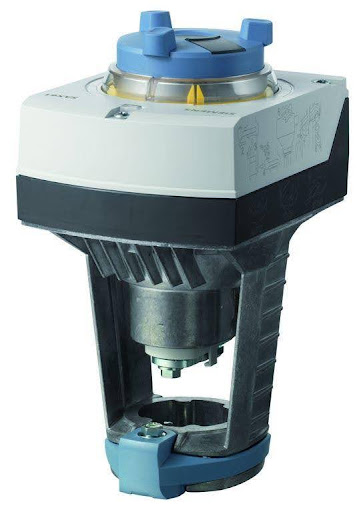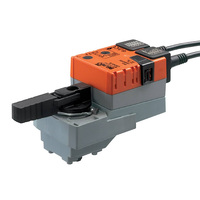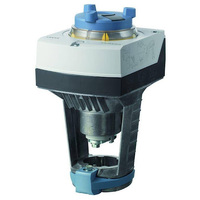What Does a Valve Actuator Do? A Guide for HVAC and Industrial Applications
.jpg)
You’re probably responsible for keeping building systems running, whether it’s a multi-storey HVAC network, a water treatment plant, or a site with strict automation requirements. And when something as small as a valve actuator fails, everything downstream grinds to a halt.
So, what does a valve actuator do? It's a mechanical or electromechanical component that moves a valve: opening, closing, or adjusting it automatically to control the flow of liquid or gas. Whether powered by air, electricity, or hydraulic pressure, valve actuators enable hands-free, precise flow control in modern systems.
For South Australian HVAC professionals, control engineers, and facilities managers, understanding actuator valves is essential to preventing downtime and keeping your systems safe, efficient, and responsive.
Why Do We Use Actuators?
In a nutshell: we use valve actuators to automate the movement of a valve (either opening, closing, or modulating it) without manual effort. But that’s just scratching the surface.
A valve actuator’s purpose is to control the movement of a valve’s internal components to start, stop, or regulate the flow of gas or liquid in a system. Without it, automated control of HVAC, water, or fuel systems just isn’t possible.

Let's say you have a commercial air conditioning system in an Adelaide office building. You don’t want someone climbing into the ceiling to twist a valve every time the temperature changes.
Instead, an actuator receives a signal from the building’s control system and adjusts the airflow instantly, whether it comes from a programmable logic controller (PLC), building management system (BMS), or local thermostat.
How Does a Valve Actuator Work?
A valve actuator works by converting a control signal, usually electric, pneumatic (compressed air), or hydraulic pressure, into mechanical movement. This movement turns or lifts the valve stem, opening or closing the valve.
There are two core motion types:
- Rotary Motion (quarter-turn or multi-turn): Used in ball valves and butterfly valves
- Linear Motion: Used in globe valves or diaphragm valves
The actuator receives input from a control system and applies force to adjust valve position. Some actuators include a feedback loop so the system knows the exact valve position at all times, key for precise control in HVAC, fluid power, and industrial settings.
What Are the Main Purposes of an Actuator?
In industrial, HVAC, and building automation settings, here’s what an actuator enables:
1. Automation
Valve actuators allow remote or programmatic control of valve positions via a control system (e.g. BMS or DDC controller). That means no need to operate the valve on-site physically.
In an HVAC system serving a multi-storey commercial building, you might have zone control valves for chilled water distribution. A Belimo electric actuator connected to the BMS can:
- Modulate valve position between 0% and 100% based on real-time temperature data.
- Respond instantly to occupancy sensors or time-of-day programming.
- Improve building energy rating by keeping cooling/heating tightly controlled per room or zone.
Common actuator types include electric (modulating or 2-position) and Pneumatic (for legacy or high-speed systems).
2. Safety
Valve actuators allow instant shut-off or redirection of fluid/gas flow during emergencies, without relying on human intervention. This is especially vital in systems handling high-pressure steam, toxic gases, or flammable fluids.
Use Case:
Let’s say you’re managing a boiler room or chilled water plant. In the event of a power failure or fire:
- A spring-return actuator can automatically return the valve to a safe default position (e.g. fully closed),
- Emergency stop buttons on-site or via BMS can trigger a total system shutdown across multiple valve points.
Example: A Johnson Controls VA-7150 actuator paired with a globe valve in a hot water loop. When the fire alarm is triggered, it automatically closes to prevent overheating or pressure spikes.
3. Efficiency
In large HVAC or water systems, energy efficiency comes down to flow control. Valve actuators are also used for optimising energy use with flow precision. The actuator’s role is to regulate flow exactly as needed, avoiding over-pumping, pressure imbalances, or thermal drift.
Modulating actuators receive continuous feedback (via 0–10V or 4–20mA signals) and adjust the valve position accordingly.
This ensures variable flow based on demand, not a static open/close state.
Energy Savings Example:
In a commercial air handling unit (AHU), equipping your chilled water valve with an electric actuator can:
- Save up to 15–30% energy, based on system size and load variability.
- Extend equipment life by reducing pump strain and short-cycling.
Bonus: Many high-end actuators integrate BACnet or Modbus for direct communication with smart controllers, helping to streamline setup and ongoing optimisation.
4. Consistency
Manual valves are subject to operator error, wear, and variation. But a high-quality actuator ensures that:
- Valve strokes are precise. You’ll get the same response every time.
- Performance doesn’t degrade with frequent use, especially when maintained.
Some facilities in high-demand zones may run cooling towers or process loops 24/7. A Siemens GCA actuator installed on a 2-way valve can:
- Operate over 100,000 full cycles in its lifetime without calibration loss.
Deliver ±1% positioning accuracy for tight fluid control, which is ideal for pharmaceutical labs, hospitals, or clean rooms.
Frequently Asked Questions
What is the function of the actuator in a valve?
The actuator moves the valve stem to open or close the valve, controlling the flow of a liquid or gas through a system. It responds to signals from control systems to ensure precise and repeatable operations.
How do I know if my valve actuator is bad?
Look for inconsistent valve movement, loss of pressure (in pneumatic systems), strange noises, or slow response times. If a control valve actuator isn’t reacting properly, it may need recalibration or replacement.
Are electric actuators better than pneumatic?
It depends. Electric actuators provide quiet and accurate control, particularly for indoor systems. Pneumatic actuators are more durable in extreme environments and are generally cheaper to maintain where compressed air is available.
Can I replace just the actuator and keep the valve?
In many cases, yes, especially if the valve body is in good shape. Make sure the replacement actuator is compatible in terms of torque, motion type, and mounting interface.
What happens if an actuator fails?
Depending on the system design, a failed actuator could leave a valve stuck open or closed. In critical systems, this can halt operations or trigger emergency shutdowns. Spring-return actuators are often used to return to a safe state in the event of failure. Shop a replacement valve actuator here.
Want Help Choosing the Right Actuator?
Need help retrofitting your HVAC system or matching an actuator to your valve? Control Traders supplies Honeywell, Belimo, Danfoss, Siemens, Schneider Electric, Johnson Controls, and more, with stock on hand and fast delivery across South Australia. Shop by brand or browse actuator valves by product name.
Do you prefer to talk it through? Our team has 40+ years of in-house experience in HVAC instruments. Call 1300 740 140 or send a message. Let's help you spec it right the first time.
Leave a comment
Popular Posts

What Is A Solenoid Valve?

How Does a Belimo Actuator Work?

Linear Actuator Uses: Applications in Various Industries





























